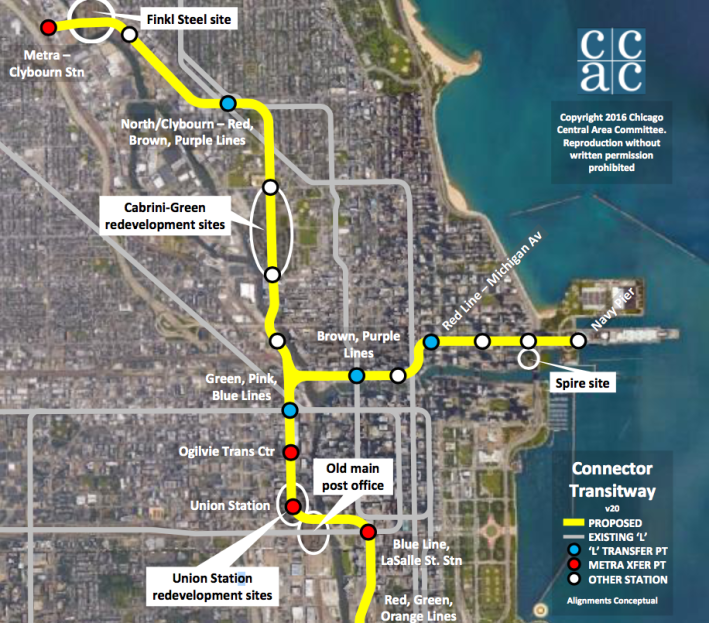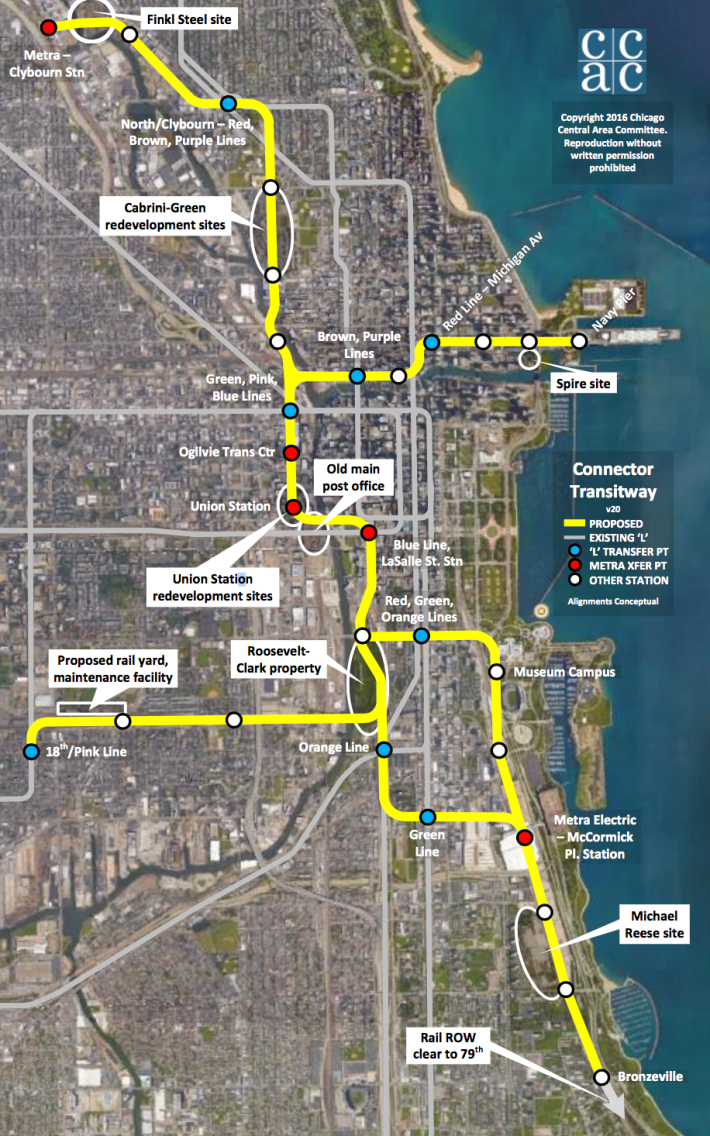Central Area Committee Pushing New Downtown Rail Transit (Again)
7:36 PM CDT on October 25, 2016

The Chicago Central Area Committee, a coalition of business executives, has proposed to build a network of automated rail lines downtown and in nearby neighborhoods to expand transit capacity for growing areas and better connect underserved communities. Their proposal includes a plan to provide rapid transit service on the Metra Electric corridor, something many South Siders have advocated for, which the committee says would help spur development.
The CCAC formed in the 1970s, and in the late '80s and early '90s it supported Mayor Richard M. Daley's plan to build light rail as a downtown circulator shuttling workers between the two West Loop train stations and high-density job centers elsewhere in the central business district. The current proposal has the backing of some of those who worked on this plan, including former UIC Urban Transportation Center director Steve Schlickman, and the Metropolitan Planning Council.
The Chicago-based MacArthur foundation is offering a single $100 million grant for an idea "that will make measurable progress toward solving a significant problem" on "any critical issue." The committee is trying to win the grant in order to kickstart their plan for a revised circulator that also heads south to better connect neighborhoods around Jackson Park and the Obama Library, which is slated to be built in the park.
The CCAC worked with the Urban Transportation Center to produce a detailed report explaining how a modern and automated train – with rolling stock that's incompatible with CTA's 'L' system – would finally connect the major downtown transit nodes with each other.
The first phase of the new system, which they call the "minimum operable segment," would link Union Station, the Ogilvie Transportation Center, the Merchandise Mart, and Streeterville using Clinton Street and the abandoned Carroll Avenue route, which is north of the Chicago River. This section, the report said, would cost $750 million, or $375 million per mile and is the most "complex part" of the complete proposal.
More downtown rail transit is necessary, the report said, because over 100 million square feet of development is projected to be built over the next 20 years, and existing rail transit can support only a third of that. Downtown is also gaining many new residents, and existing downtown bus service is atrociously slow (although the Loop Link express bus corridor represents a modest improvement that will get better if prepaid boarding is implemented at all stations.)
Additional branches would head to areas that are underserved by rapid transit. One line would run from the Loop through the former Cabrini-Green area, terminating at the North/Clybourn Red Line station. Another would pass through Pilsen along the 16th Street corridor, terminating at the 18th Street Pink Line stop. A third would run through the Roosevelt/Clark development to meet the Orange Line at 18th Street. Building these lines, the report said, "would support the Chicago Transit Authority’s efforts to increase the efficiency and reach of the existing rail system and improve distribution of workers within the enlarged central business district."
Another branch would head south from the Orange Line and the Museum Campus along the Metra Electric right-of-way to provide rapid transit service to Kenwood, Hyde Park, and Jackson Park, an idea that has strong support from transportation advocacy groups and community organizations.
The $100 million grant wouldn't actually be used to construct the new train routes. Like the circulator plan from the 1990s, a Special Service Area or transit TIF district would be overlaid downtown to levy a 0.25 percent property tax to fund the infrastructure.
CCAC would use the $100 million grant to create the Chicago Transit Redevelopment Trust, which would coordinate planning with transit agencies, and buy and invest in property along the lines, according to Crain's. After starting construction, the Trust would use these real estate holdings to generate more investment on the South Side.
That may be challenging. Relatively little development followed the construction of the Orange Line or the rebuilding of the Green Line – both of which occurred in the mid-90s. There are still dozens, if not hundreds of parcels along these existing lines that are vacant or developable.
And it's unlikely MacArthur –despite spending more of its money in Chicago than elsewhere – would fund this because of the proposal's heavy focus on commercial development.
Greg Hinz wrote in Crain's that "it's trial balloon time" and that "big-think city planning" in Chicago has "almost disappeared." This is a big proposal, by all means, but it's resurrecting a decades old idea to increase downtown transit capacity that probably should have, in some form, been built.
Stay in touch
Sign up for our free newsletter
More from Streetsblog Chicago
Today’s Headlines for Thursday, April 26
The de-facto ban on riverwalk biking is back. What should we do about it?
In the short term, new signage is needed to designate legal areas for cycling on the path. In the long term CDOT should build the proposed Wacker Drive protected bike lane.



